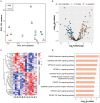Whole Transcriptome Sequencing of Peripheral Blood Shows That Immunity/GnRH/PI3K-Akt Pathways Are Associated With Opioid Use Disorder
- PMID: 35800019
- PMCID: PMC9253397
- DOI: 10.3389/fpsyt.2022.893303
Whole Transcriptome Sequencing of Peripheral Blood Shows That Immunity/GnRH/PI3K-Akt Pathways Are Associated With Opioid Use Disorder
Abstract
Background: Opioid use disorder (OUD), which is most commonly exhibited as addiction, is a persistent chronic disease that places a burden on families and society. Various peripheral traits have been linked to OUD in the past, but research on this topic is insufficient.
Methods: Seven male patients with OUD and 7 male healthy controls with matched demographic and clinical data were enrolled in this study. Peripheral blood RNA was used to construct an rRNA-removed library and a small RNA library. The peripheral transcriptomic differences between the two groups were investigated using RNA-seq. Differentially expressed messenger RNAs (mRNAs), long non-coding RNAs (lncRNAs), circular RNAs (circRNAs) and microRNAs (miRNAs) were identified by bioinformatics methods, and functional enrichment analysis with differentially expressed RNAs was performed to investigate the potential biological mechanisms of OUD.
Results: A total of 229 mRNAs (115 upregulated, 114 downregulated), 416 lncRNAs (191 upregulated, 225 downregulated), 17 circRNAs (16 upregulated, 1 downregulated) and 74 miRNAs (42 upregulated, 32 downregulated) were differentially expressed between the OUD group and the healthy control group. Functional enrichment analysis with differentially expressed mRNAs showed that immunity, GnRH secretion, and PI3K-Akt signaling pathways were associated with OUD. Immunity-, JAK-STAT-, and insulin-related pathways were enriched in functional enrichment analysis of target genes predicted by differentially expressed miRNAs.
Conclusion: We identified hundreds of differentially expressed genes that were enriched in immunity, GnRH secretion and PI3K-Akt signaling pathways. Some genes with significant changes might be used as potential biomarkers for progression and treatment of OUD.
Keywords: GnRH secretion; OUD; PI3K-Akt signaling pathway; RNA-seq; immunity; lncRNA.
Copyright © 2022 Dai, Pu, Yang, Li, He, Liu and Wang.
Conflict of interest statement
The authors declare that the research was conducted in the absence of any commercial or financial relationships that could be construed as a potential conflict of interest.
Figures



Similar articles
-
High throughput sequencing of whole transcriptome and construct of ceRNA regulatory network in RD cells infected with enterovirus D68.Virol J. 2021 Nov 7;18(1):216. doi: 10.1186/s12985-021-01686-x. Virol J. 2021. PMID: 34743709 Free PMC article.
-
Comprehensive analysis of lncRNA-miRNA-mRNA networks during osteogenic differentiation of bone marrow mesenchymal stem cells.BMC Genomics. 2022 Jun 7;23(1):425. doi: 10.1186/s12864-022-08646-x. BMC Genomics. 2022. PMID: 35672672 Free PMC article.
-
Characterization and Comparative Analysis of Whole-Transcriptome Sequencing in High- and Low-Fecundity Chongming White Goat Ovaries during the Estrus Phase.Animals (Basel). 2024 Mar 22;14(7):988. doi: 10.3390/ani14070988. Animals (Basel). 2024. PMID: 38612227 Free PMC article.
-
Whole-Transcriptome Sequencing Identifies Key Differentially Expressed mRNAs, miRNAs, lncRNAs, and circRNAs Associated with CHOL.Mol Ther Nucleic Acids. 2020 Sep 4;21:592-603. doi: 10.1016/j.omtn.2020.06.025. Epub 2020 Jun 27. Mol Ther Nucleic Acids. 2020. PMID: 32721879 Free PMC article.
-
Transcriptome expression profiles associated with diabetic nephropathy development.Mol Cell Biochem. 2022 Jul;477(7):1931-1946. doi: 10.1007/s11010-022-04420-5. Epub 2022 Mar 31. Mol Cell Biochem. 2022. PMID: 35357607
Cited by
-
Potential role of the lncRNA "HOTAIR"/miRNA "206"/BDNF network in the alteration in expression of synaptic plasticity gene arc and BDNF level in sera of patients with heroin use disorder through the PI3K/AKT/mTOR pathway compared to the controls.Mol Biol Rep. 2024 Feb 9;51(1):293. doi: 10.1007/s11033-024-09265-3. Mol Biol Rep. 2024. PMID: 38334898 Free PMC article.
-
Neuroimmune Mechanisms of Opioid Use Disorder and Recovery: Translatability to Human Studies, and Future Research Directions.Neuroscience. 2023 Sep 15;528:102-116. doi: 10.1016/j.neuroscience.2023.07.031. Epub 2023 Aug 9. Neuroscience. 2023. PMID: 37562536 Free PMC article. Review.
-
Multiomic Network Analysis Identifies Dysregulated Neurobiological Pathways in Opioid Addiction.Biol Psychiatry. 2025 Jul 1;98(1):11-22. doi: 10.1016/j.biopsych.2024.11.013. Epub 2024 Nov 29. Biol Psychiatry. 2025. PMID: 39615775 Free PMC article.
-
Deciphering the Role of Putative Novel miRNAs Encoded From the Newly Found Genomic Regions of T2T-CHM13 in the Progression of Collecting Duct Renal Cell Carcinoma.Cancer Med. 2025 May;14(9):e70925. doi: 10.1002/cam4.70925. Cancer Med. 2025. PMID: 40304310 Free PMC article.
-
MicroRNA-mediated translational pathways are regulated in the orbitofrontal cortex and peripheral blood samples during acute abstinence from heroin self-administration.Adv Drug Alcohol Res. 2023 Aug 14;3:11668. doi: 10.3389/adar.2023.11668. eCollection 2023. Adv Drug Alcohol Res. 2023. PMID: 38389822 Free PMC article.
References
-
- GBD 2016 Disease and Injury Incidence and Prevalence Collaborators . Global, regional, and national incidence, prevalence, and years lived with disability for 328 diseases and injuries for 195 countries, 1990–2016: a systematic analysis for the Global Burden of Disease Study 2016. Lancet. (2017) 390:e38. 10.1016/S0140-6736(17)32647-8 - DOI - PMC - PubMed
LinkOut - more resources
Full Text Sources
Molecular Biology Databases
Miscellaneous

